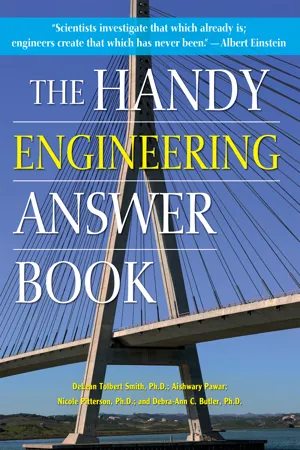Technology & Engineering
Mechanical Engineering
Mechanical engineering involves the design, analysis, and manufacturing of mechanical systems and components. It encompasses a wide range of industries, including automotive, aerospace, and energy. Mechanical engineers apply principles of physics and materials science to develop innovative solutions for various mechanical challenges.
Written by Perlego with AI-assistance
Related key terms
4 Key excerpts on "Mechanical Engineering"
- eBook - ePub
- DeLean Tolbert Smith, Aishwary Pawar, Nicole P. Pitterson, Debra-Ann C. Butler(Authors)
- 2022(Publication Date)
- Visible Ink Press(Publisher)
Mechanical Engineering What is Mechanical Engineering? Mechanical Engineering is one of the broadest engineering professions. It focuses on making innovations to address human issues with an adequate understanding of core areas—for example, knowledge and application of mechanics, thermodynamics, materials science, etc., to deal with the design, development, and utilization of machines. For this design and analysis, mechanical engineers use computer-aided design (CAD), computer-aided manufacturing (CAM), and product life cycle management. Thus, it includes the design, production, and operation of machinery. HISTORY What is the history of Mechanical Engineering? With the development of civilization, the emergence of Mechanical Engineering started from the first steam engine, which is dated from ancient Greece, the work of Hero (or Heron) of Alexandria. Then, at that point, during the Islamic Golden Age (from the seventh to the fifteenth century), Ismail al-Jazari’s book The Book of Knowledge of Ingenious Mechanical Devices was written in 1206. The first professional society for mechanical engineers, the Institute of Mechanical Engineers, was formed in the United Kingdom in 1847. The first power-driven machines were made during the nineteenth century; then, during the twentieth century, more advanced systems were built. The development of physics and machine tools during the nineteenth century permitted the separation of Mechanical Engineering from the rest of the engineering subdisciplines. This led to the manufacturing of machines and engines to power them. Indeed, one of the primary difficulties of Mechanical Engineering was the creation of power-driven systems - eBook - ePub
- Carolina Machado, J. Paulo Davim, Carolina Machado, J. Paulo Davim(Authors)
- 2017(Publication Date)
- De Gruyter(Publisher)
This chapter was prepared and written in presentation format, so it is easy to read and follow. I hope all readers will find it useful.7.1The objective of Mechanical Engineering
Engineering is an occupation whose goal is to develop methods for the economic use of resources, potentials, and materials in nature, for the benefit and welfare of human beings. This is accomplished by a reasoning process of experience and practical knowledge gained from the fundamental sciences and mathematics.The main objective of engineering is to develop existing technology and bring into existence new systems for human use by introducing the design and production of innovative technical applications in consideration of scientific knowledge.The most important infrastructure in terms of producing unique technology is fundamental scientific research and qualified manpower and brain power.The capabilities and contributions of engineers are so important that those capacities affect directly the assessment by educated people of the potential of a society or country and even the entire world.During the engineering execution period, engineers generally think, search, plan, design, and conceive projects and implement, produce, and manage the related industrial and business activities. The research capabilities of engineers are as important as their scientific knowledge and field experience.In addition to producing unique technology, engineers should carry out tasks related to technology transfer, adaptation, matching, customization, implementation, and usage.The place of Mechanical Engineering in society and its importance can only be described by introducing and presenting in detail the jobs involved in the field. A strong relationship exists between a country’s reconstruction and industrialization, and this relationship cannot be ignored. Industrial progress is one of the cornerstones of community development. Mechanical Engineering is one of the most important driving forces for in periods of industrialization and development for a country and for the world. - eBook - ePub
- Sunny Y. Auyang(Author)
- 2006(Publication Date)
- Harvard University Press(Publisher)
30To understand engineering as exemplified in Watt, recall the two aspects of technology, the organizational and the physical. Organizational technology, which concerns the orchestration of human and material resources for production, includes entrepreneurship and business administration. Many mechanical engineers, including Watt, Fairbairn, and Stephenson, were also entrepreneurs. Physical technology involves “physical” forms in the widest sense, including computers and information processing algorithms. Four basic platforms of physical technology that enable higher-level constructions are materials, power, tools, and control. We touched on materials in the preceding section and will look at the other three platforms here. Steam engines provided power that freed production from muscle and geographical locations of wind and water. The engines themselves required adequate machine tools for their production and control mechanisms for operation. Power, tools, and control were first developed in Mechanical Engineering, although other engineering branches joined in as physical technology advanced.Scientific Empiricism in EngineeringCivil and Mechanical Engineering differ in the general characteristics of their products and their processes of production. Civil engineers produce constructions, mechanical engineers machines. Constructions are rather homogeneous in function and form. Although each suspension bridge poses problems peculiar to its requirements and environment, it shares salient features with other suspension bridges. Thus civil engineering structures are more susceptible to generalization and mathematical representation, and structural analysis was the first engineering science to mature. In contrast, machines serve countless complex functions. Their forms and operations, diverse and specialized to their functions, are less prone to generalization and theorization. General principles of heat or fluid flow that underlie various types of engines were discovered later and only with significant input from engineering practices. Mechanical Engineering has tended to be more empirically oriented, especially in its early days when the relevant sciences were embryonic. Natural science was not irrelevant, but its contributions were more in general ways of systematic reasoning and controlled experimentation than in specific theories and pieces of information. This is illustrated in Watt’s experience. - eBook - ePub
The Economy of Workshop Manipulation
A logical method of learning constructive mechanics. Arranged with questions for the use of apprentice engineers and students.
- John Richards(Author)
- 2018(Publication Date)
- Perlego(Publisher)
To estimate how much is yet to be learned in Mechanical Engineering, we have only to apply the same test, and when we contrast the great variance between the designs of machines and the diversity of their operation, even when applied to similar purposes, their imperfection is at once apparent. It must, however, be considered that if the rules of construction were uniform, and the principles of machine operation as well understood as the strength and arrangement of material in permanent structures, still there would remain the difficulty of adaptation to new processes, which are continually being developed.If the steam-engine, for instance, had forty years ago been brought to such a state of improvement as to be constructed with standard proportions and arrangement for stationary purposes, all the rules, constants, and data of whatever kind that had been collected and proved, would have been but of little use in adapting steam-engines to railways and the purposes of navigation.Mechanical Engineering has by the force of circumstances been divided up into branches relating to engineering tools, railway machinery, marine engines, and so on; either branch of which constitutes a profession within itself. Most thorough study will be required to master general principles, and then a further effort to acquire proficiency in some special branch, without which there is but little chance of success at the present day.To master the various details of machine manufacture, including draughting, founding, forging, and fitting, is of itself a work equal to most professional pursuits, to say nothing of manual skill; and when we come to add machine functions and their application, generating and transmitting power, with other things that will necessarily be included in practice, the task assumes proportions that makes it appear a hopeless one. Besides, the work of keeping progress with the mechanic arts calls for a continual accretion of knowledge; and it is no small labour to keep informed of the continual changes and improvements that are going on in all parts of the world, which may at any time modify and change both machines and processes. But few men, even under the most favourable conditions, have been able to qualify themselves as competent mechanical engineers sooner than at forty years of age.
Index pages curate the most relevant extracts from our library of academic textbooks. They’ve been created using an in-house natural language model (NLM), each adding context and meaning to key research topics.



